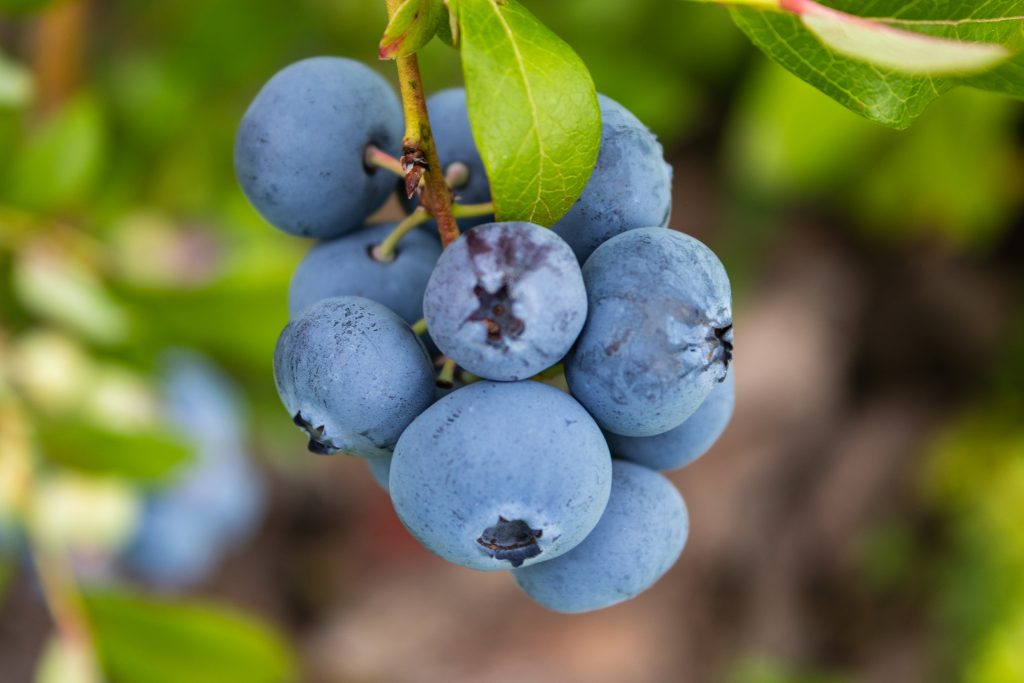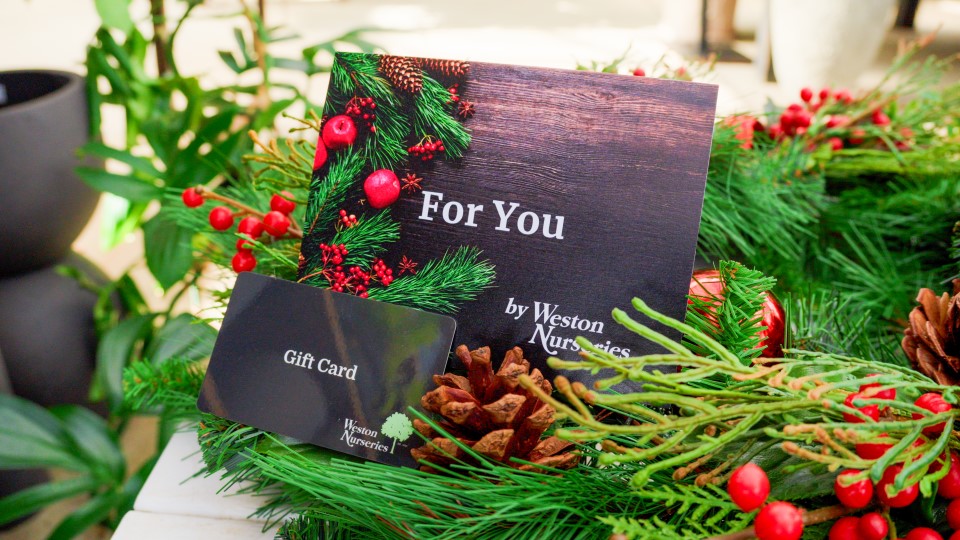Vaccinium species grow naturally throughout the eastern North America and have long been valued for their tasty fruit in summer. These shrubs are ornamental as well as fruit bearing, and they are as much at home in a landscape or flower garden as in a designated edibles garden. Some varieties are suitable to be grown in containers.

In summer foliage is dark green, sometimes with a bluish cast, changing to tones of yellow, brilliant red, and orange in autumn, rivaling the dramatic beauty of the invasive Burning Bush (Euonymus alatus). Handsome yellow-green to reddish stems offer winter interest. And, when spring arrives again, a profusion of white bell-shaped flowers attracts pollinators.
Choose from a wide range of growth types, fruiting seasons and berry sizes. Although most highbush varieties are somewhat self-pollinating, we recommend planting two or more varieties for proper cross-pollination and optimal fruit yield. Additionally, the blueberry harvest season can be extended from early summer into fall by planting cultivars that ripen at different times.
SIZES
There are three types of blueberries distinguished from each other by their heights.
Highbush varieties (Vaccinium corymbosum): Standard “pick your own” selections, ripening from June through summer. Best grown in groups to maximize yield. Mature height is about 6’. Extremely cold hardy and mostly pest resistant. Hardy to zone 5 unless otherwise noted.
Half High varieties: Developed at the University of Minnesota, these are distinctly compact with mature height in the 2-3’ range. Hardy to zone 5 unless otherwise noted.
Lowbush varieties (Vaccinium angustifolium): Densely branched native groundcover type with smallish blue fruits ripening in summer. Similar to highbush in cultural requirements. Hardy to zone 5 unless otherwise noted.
SPACING
Blueberries can be used both as a culinary plant and ornamentally in the landscape. As an informal hedge, space them about 3-3.5’ on center and as a grouping in the landscape, about 4-5’ on center to allow for the different pruning which they will receive in each situation.
REQUIREMENTS:
SOIL
The most important factor in growing blueberries is the acidity of the soil. A pH range of 4.0-5.5 is best. New England soils are normally acidic, but it is wise to test the soil in the planting area. If the soil needs to be acidified, add ammonium sulfate fertilizer or cottonseed meal to the planting backfill mix.
Blueberries also need soil with plenty of organic matter and will not tolerate poorly drained or overly heavy soil conditions. Lean soils should be amended with compost and clay soils with plenty of peat moss.
MOISTURE
Blueberries do best in well-drained, uniformly moist soils. Apply enough water to wet the soil to a depth of 12” and be certain to pay particular attention to water requirements during the growing season in order to optimize fruit production.
LIGHT
Full sun (6 or more hours) is best for optimal fruiting but they will also tolerate part shade.
PLANTING
Most of the plants sold here at Weston Nurseries are container grown. Once you have determined the soil pH and planned any proper correction, plant your blueberry at the same depth it was growing in its original container. If you’re growing your blueberries in containers, choose one that is slightly wider and deeper than the original pot, has drainage holes, and can withstand outdoor winter conditions.
MULCHING
Blueberries do not like weed cover around the base, so it is important to use some type of mulch to discourage weeds and retain moisture. Use a 4-6” layer, deeper than what is normally used for shrubs. Pine bark, pine needles, leaf mold, or even sawdust can be used.
POLLINATION
Hybrid blueberries produce the best fruit when there is an opportunity for cross-pollination. Planting two or three different cultivars with overlapping bloom times will enhance fruiting.
FRUIT PRODUCTION
Fruit production in the first year should not be expected, and full fruiting may take 2-3 years. When mature, six plants should produce 15-20 quarts in a season. A blueberry plant should produce for about 25 years if properly maintained. Each variety usually yields for a 2 to 3-week period.
PRUNING
When first planting blueberries, it is best to remove up to 1/3 of the weaker branches, to enhance root system development. No pruning is required for the next three years. In the fourth and following years, prune annually during dormancy. Remove the lower weak branches, some of the older stems, and most branches under 6” in length, preferably in winter or during early spring before the buds begin to swell.
FERTILIZING
Incorporate a handful of bone meal, triple phosphate (0-46-0), or rock phosphate (0-3-0) with backfill soil in the initial planting hole. Blueberries should be fertilized annually thereafter with a balanced fertilizer for acid-loving plants, blended for azaleas and rhododendrons. This should be spread in two applications: the first at blossom time and the second a month later. Spread the fertilizer on the ground in a circle within the drip line of the plant.
HARVESTING
The harvest period for blueberries in our area will range from July 1 through late August depending on the varieties and the weather. An important consideration is the protection of the ripe fruit from birds starting about a week before the fruit ripens. You can build a permanent netting structure using a pipe frame over the entire planting, or you can cover them individually with netting that reaches to the ground on all sides. Pick the berries when they are fully ripe on the plant, solid blue and with a whitish glow. Blueberries will produce 2 to 3 weeks from the first ripe berry to the last one picked. To harvest for a longer period, you should plant early, midseason, and late cultivars.
PROBLEMS
Blueberries are relatively easy to care for and generally have few pests other than marauding birds. Other infrequent issues include yellowing of the leaves due to alkaline soil, fungal disease and insect pests. If you are having any problems with your blueberries, feel free to consult us. A photo is often helpful to us in ascertaining the cause of the problem.






